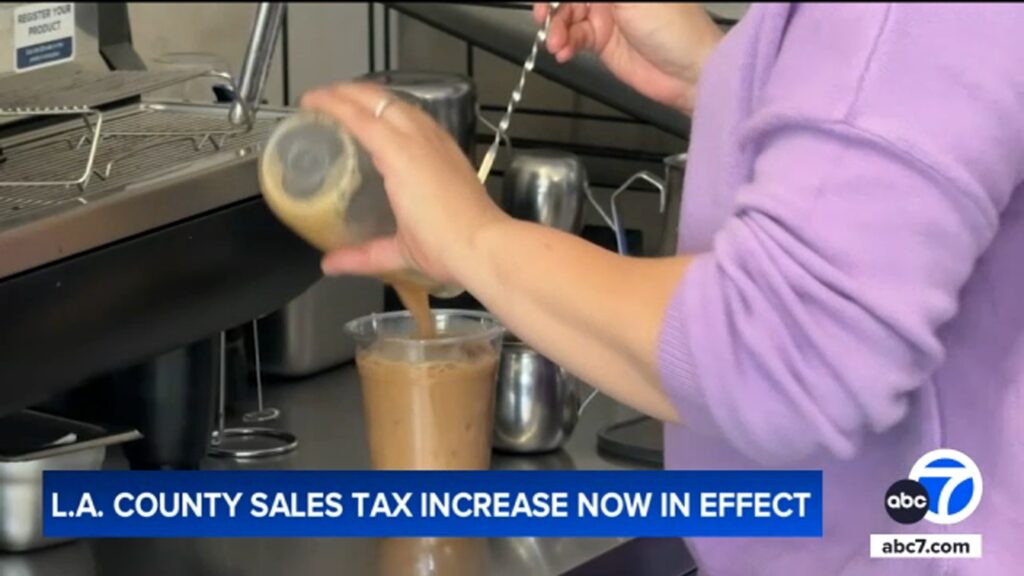

LOS ANGELES (KABC) — A revamped anti-homelessness funding measure approved by Los Angeles County voters in November took effect Tuesday, meaning the county’s sales tax increased.
Los Angeles County voters approved Measure A — a half-cent sales tax — to help maintain existing programs and provide more revenue to address the homelessness crisis in the region. The measure will replace a quarter-cent county sales tax approved by voters in 2017, under then-Measure H. That sales tax had a 10-year lifespan, and it was set to expire in 2027.
Measure A — the Affordable Housing, Homelessness Solutions and Prevention Now measure — will remain in perpetuity unless it is repealed by voters.
Lancaster and Palmdale will experience the largest hike, with rates rising from 10.25% to 11.25%. Both cities approved an additional 0.75% tax on top of the countywide increase.
Other cities including Compton, Lynwood and South Gate will see the second-largest increase from 10.25% to 10.75%
“When prices go up, people are making decision and a lot of those decisions are to stay home, to cook their own meals,” said Stuart Waldman, president of the Valley Industry and Commerce Association.
The owner of Cake & Coffee House in South Gate says the new tax increase will affect all of her sales. Saida Castro anticipates the average drink to cost $6.
“Right now, I have to think about the supplies and everything that’s going to… cost more. And it has me wondering if I increase it for my customers, they’re going to feel it…,” she added.
As business owners adjust, customers are also preparing for the impact of higher prices. Luz Dayana Venegas, of South L.A., told Eyewitness News she plans to cut some spending.
“Aside from how it’s going to impact businesses, will the money generate what it claims it will? And if people spend less money, then it won’t,” said Waldman.
What will Measure A pay for?
According to the written language of the measure, about 60% of revenue generated by the sales tax will cover costs for homelessness services and 15% of that will be distributed to cities based on the annual point-in-time count of homeless people. Another 35.75% will support the L.A. County Affordable Housing Solutions Agency, which was created in 2023 by the state Legislature to oversee homeless solutions.
The measure also mandates regular oversight and reporting on the following outcomes:
— Increase the number of people moving from encampments on the streets into permanent housing;
— Reduce the number of people with mental illness or substance use disorders who are experiencing homelessness;
— Increase the number of people permanently leaving homelessness;
— Prevent people falling into homelessness; and
— Increase the number of affordable housing units in L.A. County.
The measure requires elected officials and related agencies to establish goals every five years and to track that progress.
Last week, the Los Angeles County Board of Supervisors approved its homeless funding plan, which allocated $656 million from Measure A, $209 million in unspent Measure H funding and $42.6 million in state grants.
The Board of Supervisors is expected to vote on a proposal Tuesday that, if approved, would give the county direct control over funds it currently sends to the Los Angeles Homeless Service Authority, also known as LAHSA, a city-county joint agency.

The Los Angeles City Council approved a similar motion, calling for a study to bypass LAHSA and manage contracts directly with homeless service providers.
Both bodies have taken serious steps to limit LAHSA’s power over funding following scathing reports that alleged the agency misused or mismanaged funds, among other issues.
The homeless agency was created in 1993 to address homelessness in Los Angeles County. It is the lead entity that coordinates and manages federal, state, county and city funds for shelter, housing and services to people experiencing homelessness throughout the L.A. Continuum of Care, which encompasses all cities in the region — with the exceptions of Long Beach, Pasadena and Glendale.
LAHSA officials have disputed some of the findings of the audits and urged officials to continue their partnership. The homeless agency has begun efforts to bolster transparency through the creation of accessible databases, which better track available shelter beds and outcomes of services.
Officials at the agency said they anticipate a 5% to 10% decrease in unsheltered homelessness in the region, which would mark the second consecutive year of such a decline.
The preliminary results are in line with last year’s outcome, which showed a 10.7% and 5.1% decrease in unsheltered homelessness within the city and the county of Los Angeles, respectively. The final results of the 2025 count are expected to be released in late spring or early summer.
“When I first came to LAHSA, I publicly stated that we wanted to reduce unsheltered homelessness within three years,” LAHSA CEO Va Lecia Adams Kellum said in a statement earlier in March. “We’ve done it in two.”
The agency hailed the early results, which officials say show the region is on the right track to “solving” homelessness.


